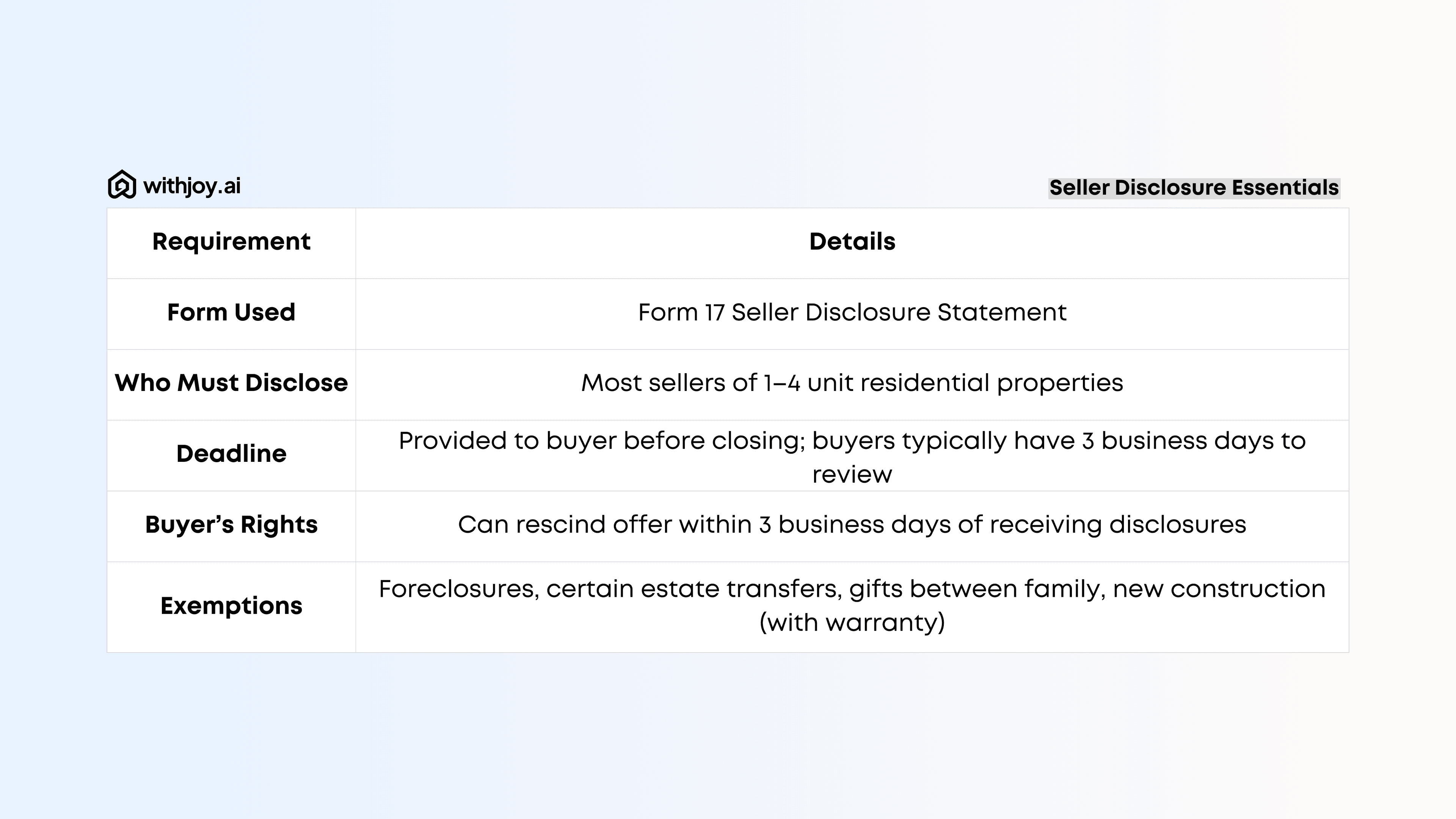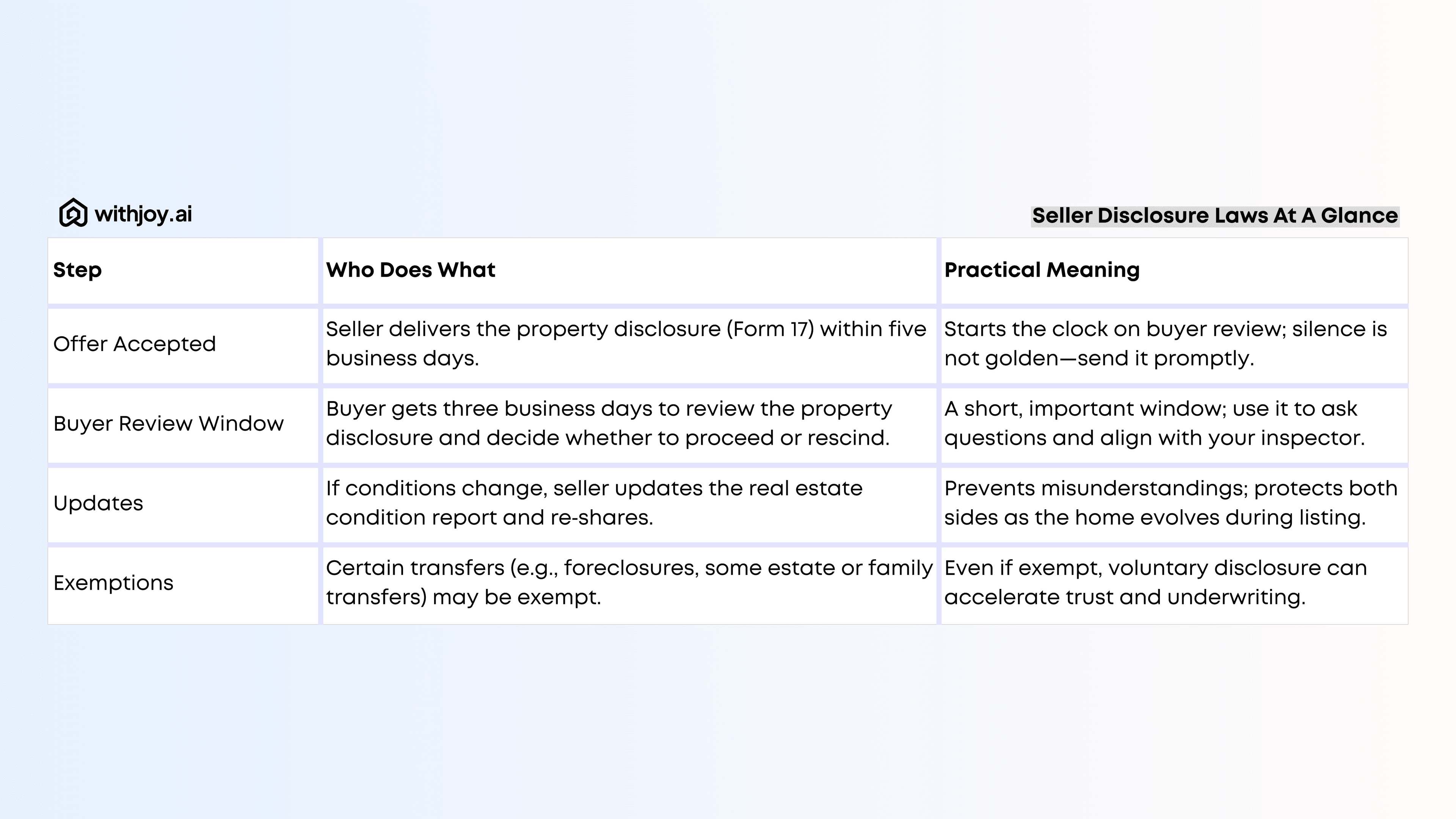7 minutes read
Understanding Seller Disclosures
Seller disclosure FAQs answered, protect your investment and save.
KB
Kyler Bruno
08/24/2025

Seller Disclosures in Washington State
A seller disclosure is a legally required document where a home seller provides information about the property’s condition. It gives buyers a snapshot of known issues, ranging from leaky roofs and past flooding to HOA rules or boundary disputes.
In Washington State, this document is called the Form 17 Seller Disclosure Statement. It’s not optional, most residential property sales require it, unless you fall under one of the rare exemptions (like a foreclosure sale or certain estate transfers). Think of it as the seller’s version of “full disclosure.” It doesn’t replace a home inspection, but it sets expectations early and helps avoid surprises later.

All About Seller Disclosures
Buying or selling a home in Washington is exciting, but there’s also a lot of paperwork involved. One of the most important parts of the process is the seller disclosure a document that ensures transparency between sellers and buyers. If you’re wondering what you need to reveal, what buyers should look out for, or how this process impacts negotiations, this guide breaks it all down in plain language.This article covers:
- What seller disclosures are (and why they matter).
- Washington State’s seller disclosure laws.
- Common issues disclosed by sellers.
- What buyers should do after reviewing disclosures.
- How seller disclosures affect negotiations.
- Key FAQs about seller disclosure requirements.
- A quick video call-out for those who prefer watching.
- Why WithJoy.AI makes buying and selling easier.
Washington State Seller Disclosure Requirements
Washington has clear laws about disclosures. Here are the essentials:
Washington law requires sellers to disclose material defects issues that could impact a home’s value, safety, or appeal. Even if the issue has been repaired, sellers should disclose it if they’re aware of it.

Washington Real Estate Disclosure Laws at a Glance
The framework for seller disclosures in Washington sits inside the Residential Real Property Transfer Act. While attorneys and brokers live in the details, buyers and sellers mainly need the sequence and the levers it creates.
Below is a friendly, at‑a‑glance table you can reference while you read Form 17 or prepare your listing paperwork.

What Typically Appears in a Property Condition Disclosure
A property condition disclosure is designed to be sweeping without becoming unmanageable. It nudges sellers to answer in plain language and invites buyers to follow the breadcrumbs with their own experts. Use this table as a translation key:

Common Issues Disclosed by Sellers
Here are some of the most common items that appear in Washington seller disclosures:
- Water Damage & Leaks – Basement flooding, roof leaks, or past pipe bursts.
- Roof Condition – Age, repairs, or full replacements.
- Plumbing & Electrical – Outdated wiring, faulty plumbing, or sewer issues.
- Pests – Termites, carpenter ants, rodents, or other infestations.
- Structural Problems – Foundation cracks, settling, or major repairs.
- Legal Matters – HOA disputes, boundary disputes, or liens on the property.
- Environmental Concerns – Asbestos, lead paint, underground oil tanks, or nearby hazardous sites.
- Appliances & Systems – Known defects in heating, cooling, or built-in appliances.
Seller Disclosures vs. Home Inspections
It’s important to note: seller disclosures are not a replacement for a home inspection.
- Disclosures = Seller’s knowledge of the property.
- Inspections = Professional evaluation of current condition.
Buyers should always order an independent inspection even if the disclosure looks “clean.” Sometimes sellers are genuinely unaware of issues, and other times the inspection uncovers new problems.

How Buyers Use Seller Disclosures
For buyers, disclosures are a powerful tool. They can:
- Reveal hidden issues before closing.
- Provide leverage for negotiation (e.g., ask for repairs or credits).
- Serve as legal protection if major undisclosed defects are discovered later.
Example: If a seller discloses that the roof was last replaced 20 years ago, the buyer can request either a roof replacement before closing or a reduction in purchase price.

How Seller Disclosures Affect Negotiations
Seller disclosures often lead to renegotiations. Here’s how it plays out:
- If disclosures reveal minor issues, buyers may still proceed but request small concessions.
- If disclosures reveal major issues (like foundation damage), buyers may walk away or push for a significant discount.
- If buyers feel confident issues are manageable, disclosures actually build trust, sellers who are upfront tend to make buyers feel more secure.

Penalties for Failing to Disclose
In Washington State, failing to disclose known issues can lead to:
- Contract cancellation.
- Lawsuits for misrepresentation.
- Financial damages to cover repairs.
Simply put: honesty is the best (and legally safest) policy.

Video Call-Out: Seller Disclosures Explained in 2 Minutes
Prefer watching instead of reading? Here’s a quick video explaining seller disclosures and why they matter for both buyers and sellers.
FAQs About Seller Disclosures in Washington
1. What happens if a seller lies on a disclosure?
In Washington State, failing to disclose known defects or intentionally misrepresenting the truth on Form 17, can have serious consequences. If a buyer later discovers that the seller knowingly lied, they may have the right to:
- Rescind the contract before closing.
- File a lawsuit for misrepresentation or fraud.
- Recover damages equal to the cost of repairs, lost property value, or even legal fees.
For example, if a seller knows the basement floods every winter but checks “No” on the disclosure form, and the buyer finds out post-closing, the seller could be financially liable. Even if the sale has closed, Washington courts often side with buyers if the defect was material and intentionally concealed.
2. Do I need to disclose repairs I’ve already fixed?
Yes,Washington law requires sellers to disclose both past and present issues if they could materially affect the property. That means if you had:
- A leaking roof that was repaired.
- A sewer line that was replaced.
- Termite damage that was treated.
…you still need to disclose those issues. Buyers want to know the property’s history, not just its current state. In many cases, disclosing past repairs actually works in your favor it shows that you maintained the property responsibly and invested in improvements.
3. How long does a buyer have to review disclosures?
Under Washington law, buyers typically have 3 business days after receiving Form 17 to review the disclosures. During this review period, buyers can:
- Cancel the purchase agreement without penalty.
- Ask for clarification or additional documentation.
- Decide whether to proceed, renegotiate, or walk away.
If the buyer does not act within those 3 days, the right to rescind usually expires. That’s why it’s important for buyers to review disclosures immediately and schedule a home inspection as soon as possible.
4. Are disclosures required for new homes?
Newly built homes are usually exempt from the Form 17 Seller Disclosure Statement, but that doesn’t mean buyers are left unprotected. Instead, Washington law requires most new construction to come with a builder’s warranty, covering:
- Structural integrity.
- Major systems like plumbing, heating, and electrical.
- Compliance with building codes.
Buyers should always request a copy of the builder’s warranty and carefully review its terms, including what is covered and how long the coverage lasts. Even though disclosures aren’t required, it’s wise to ask the builder or developer about known issues or past complaints in the subdivision.
5. Do disclosures cover appliances?
Yes. Washington’s Form 17 specifically asks sellers to disclose the condition of appliances and built-in systems. This includes:
- Furnaces, heat pumps, and HVAC systems.
- Hot water heaters.
- Kitchen appliances like ovens, dishwashers, and built-in microwaves.
- Electrical and plumbing systems.
If a seller knows that the furnace doesn’t heat properly, or that the dishwasher leaks occasionally, they must disclose it. Buyers should still test appliances during the home inspection, but disclosures give an important first look at potential issues.
6. Can a buyer waive disclosures in Washington?
In very limited cases, yes, but it’s rare. Washington law allows buyers to waive their right to receive a disclosure statement, usually when purchasing property “as-is.” However, even in “as-is” transactions, sellers cannot intentionally conceal defects they are aware of.
For buyers, waiving disclosures is risky, you give up the right to rescind the purchase based on the disclosure statement. Most real estate professionals strongly recommend never waiving disclosures, especially in older homes where hidden issues are more likely.
7. What if something changes after the seller completes the disclosure?
If a new issue arises after the seller has already submitted the disclosure form — for example, the roof develops a leak, or a water pipe bursts — the seller is legally required to update the disclosure statement or notify the buyer in writing.Failure to do so could expose the seller to liability. Buyers should always confirm that they have received the most recent version of Form 17 before closing.
8. Are seller disclosures the same in every county in Washington?
Yes, the Form 17 Seller Disclosure Statement is standardized across Washington State. Whether you’re selling a home in Seattle, Spokane, Tacoma, Olympia, or rural areas, the same statewide disclosure rules apply.That said, some counties or cities may have additional disclosure requirements for local issues, such as:
- Seismic risk zones.
- Floodplain status.
- Shoreline management rules.
Buyers should always check with their real estate agent or local county office to make sure no additional disclosures apply.

Final Thoughts
Seller disclosures are a cornerstone of real estate transactions in Washington. They protect buyers, keep sellers compliant, and make the entire process more transparent.
Whether you’re preparing to sell or reviewing a disclosure as a buyer, knowing what’s inside (and what it means) will help you make smarter decisions. With the right team and the right technology handling disclosures and negotiations doesn’t have to be stressful. That’s where WithJoy.AI comes in.
The Big Picture: Transparency Creates Momentum
Seller disclosures are not about catching someone out; they are about building a shared, accurate understanding of a home so that money, timing, and expectations line up.
In a state where weather, geology, and construction eras vary widely, a property disclosure and a real estate condition report act as the common language that lets everyone move forward without guesswork. Keep this guide nearby, refer to the tables when you need them, and remember: when in doubt, disclose and document.
Why WithJoy.AI Makes This Easier
At WithJoy.AI, we simplify the home buying and selling process:
AI-Powered Home Search – Find homes that truly match your needs.
Fast Tours – Schedule same-day tours with top local agents.
Smart Offers – Data-driven insights to make your offer stand out.
Commission Rebates – Get cashback on your home purchase.
Seamless Closing – From disclosures to inspections, we guide you every step.
👉 Ready to buy or sell in Washington? Start with WithJoy.AI today and make your next move smarter, faster, and more rewarding.

Related Guides

Homebuyer's Ultimate FAQ on Closing Costs
A guide answering all your questions about closing costs when buying a home.
KB
Kyler Bruno
08/13/2025

Who Pays the Inspection When Buying a House
Home inspection is a visual, non‐invasive check of major systems (structure, roof, plumbing, etc.)
KB
Kyler Bruno
10/22/2025

Real Estate Commission Rebates Explained
Almost all homebuyers leave money on the table.. don’t be one of them!!
KB
Kyler Bruno
07/11/2025
Full Service Home Buying - WithJoy.AI
Find Your Home Today
The future is here. Buy your next home WithJoy.AI
Trending Neighborhoods

Best Places to Retire

Best Affordable Areas Near Seattle

Best for Young Professionals

Best Family Neighborhood Seattle
